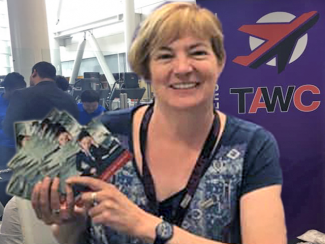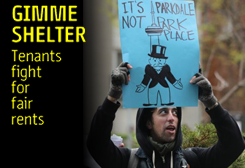FLYING HIGH
Airport workers take solidarity to new heights

Tracy Rowan gets postcards signed to support TAWC campaign against unpaid work
WORKERS AT THE TORONTO AIRPORT ARE FLYING HIGH. They dare to think and act in solidarity, all on their own. It’s a new take on the old socialist ideal of workers councils—and it works.
It used to cost $27.50 to ride the UP Express train to Pearson International Airport. Now it costs $12.50—just $3.50 for any airport worker. The Toronto Airport Workers’ Council (TAWC) is a big part of the reason why.
The TAWC is made up of activists from among the 50,000 workers at the airport. Most are members of one of six unions at the airport, some are not. They see themselves more as community activists than union champions. Their community is everyone who works at the airport regardless of race, gender, age, job or union membership.
Lower fares and high hopes
The TAWC campaigned hard to bring down the high cost of just getting to work. They found allies in community groups like TTCriders and the Clean Train Coalition.
Tracy Rowan is a flight attendant, a Canadian Union of Public Employees (CUPE) member, and TAWC activist. “We got the fare changed because we crashed [Metrolinx’s] meeting. That’s some of the most fun I’ve ever had as a group, crashing a board meeting, and seeing things change because of what we did.”
For Sean Smith, a Unifor member and TAWC activist the campaign’s success was proof that the TAWC’s model of forming links between community groups and trade unions within the workplace was an effective way to fight.
“It’s pretty much wall-to-wall airport organized now,” says Sean. “The critical thing about it is, we’re all workers.”
Sean believes that it’s crucial to see the workplace as a community. This is what allows workers at Pearson to reach across collective bargaining agreements and compartmentalized struggles to form a common front.
“Everywhere you look, there’s workers from 249 other companies going through the same issues. You have to start looking at things from a broader community perspective. If your house and every other house in your neighbourhood is on fire, you have a community issue, not just a house issue,” he emphasizes.
Another form of worker solidarity
Six unions are members in the solidarity pact that forms the TAWC. Though the council is a completely volunteer-led organization, the bulk of dedicated TAWC activists are local-level officers within these unions. However, Sean Smith makes it clear that he does not consider the TAWC to be a form of “dual unionism”.
The TAWC’s growth has been slow but steady. Their main strategy is to build solidarity through one-on-one conversations with their work mates.
Another tactic is to become more visible in the airport:
- they negotiated with the employer to maintain information tables in the walkways going to and from employee parking
- they hand out leaflets at transit hubs and put up posters in lunchrooms
- they take advantage of pre-existing union infrastructure like newsletters and local meetings to communicate with workers.
Paul Christopher Gray, assistant professor of labour studies at Brock University says, “What we thought was quite interesting about the TAWC was that it is a workers’ organization. It is not a union, and yet unlike a lot of the other proposed alternative forms of workers’ associations, it is based in a workplace, at the site of production. It engages in direct actions, things that can be disruptive at the point of production, things that the alternative forms of labour organizing usually can’t be.”
“A much stronger, more powerful tool”
Workplace actions at Pearson need to be big and fast, in order to have an impact on employers before the government has a chance to deploy back-to-work legislation.
“When one group of workers goes on strike, if they are part of the six solidarity pact unions, we all engage in solidarity actions on their behalf,” says Smith.
This can include tactics from work to rule, to solidarity rallies and phone zaps, where workers will tie up phone lines by repeatedly calling head offices en masse. “So, the strike becomes a much stronger, more powerful tool.”
Airport workers have many different private employers with many different contracts. This “contract flipping” makes it difficult for unions to build a base of activists and organizers on the shop floor, and it also suppresses wages across the airport.
“People are afraid. It’s the fear. It’s the learned helplessness,” say TAWC activist Yavar Qadri. He believes the larger sense of community fostered by the council can help overcome that feeling.
Despite their successes, the council still raises concerns about “dual unionism”—the development of a parallel structure operating inside or outside an existing trade union. TAWC activists remain firm that the workers’ council is not, and will never be, that. They assert the whole, and only, purpose of the council is to be complementary to existing union structures.
“This is not dual unionism, says Sean. We’re all proud of our respective unions; we all work within our respective unions.
“But when it comes to issues that involve multiple groups of employers, multiple unions, collective community issues, this is where the community union model comes in. It fills the gap that collective bargaining can’t; it does not replace collective bargaining.”
“Actually, it’s kind of a unique thing and you don’t really figure it out until you’ve been at a few meetings or gone to an event,” says CUPE activist Tracy Rowan. “We’re all figuring it out together, but we’re independent of the politics going on in Ottawa or in union headquarters.”
“These things that you learn in the union movement, when they work, they are used by everyone in the union movement,” says Yavar Qadri. “I see the TAWC growing. I don’t know how fast that’s gonna be, but it’s going to grow to be very powerful, as big as the airport is, as powerful as the airport is.
- 30 -













Add new comment